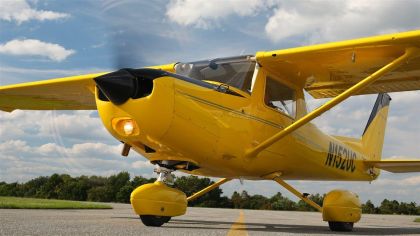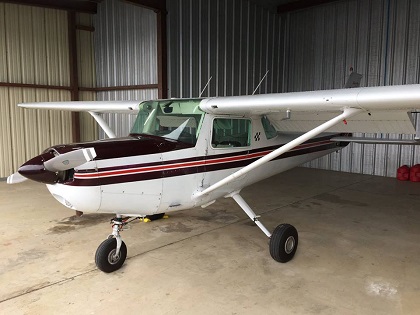The Aircraft Spotlight feature looks at an airplane type and evaluates it across six areas of particular interest to flying clubs and their members: Operating Cost, Maintenance, Insurability, Training, Cross-Country, and Fun Factor. This article on the Cessna 150 originally ran in 2015 and has been updated to include information on the Cessna 152.
The Cessna 150 has been used to teach pilots to fly for decades and is still going strong. It is durable, simple to fly, and inexpensive to operate. It may not be fancy, but most pilots have a soft spot for this reliable little trainer. The same is true for the Cessna 152, which debuted in 1978 as an update to the venerable C-150 and was produced until 1985, when Cessna ceased all piston production for a number of years.
In 2015, then Pocono Mountains Flying Club President Paul Houle shared how his club has used the Cessna 150 to build the flying club. The Westminster Aerobats Flying Club, which is in the process of being formed in Maryland by AOPA Flying Club Initiative staff (see this month’s Club Spotlight), shared some information about its Cessna A152 Aerobat.
The main difference between the C-150 and the C-152 is the C-152 has the Lycoming O-235 and the max gross weight was increased to 1,670 lbs. The C-150 has the O-200 and a max weight of 1,600 lbs. Another difference is the C-152’s flaps are limited to 30 degrees, while the C-150 can deflect to 40 degrees.
Operating Cost: 5 stars
Maintenance: 5 stars
Insurability: 5 stars
Training: 5 stars
Cross Country: 3 stars
Fun Factor: 4 stars
Overall: 4 stars
Operating Cost (5 stars)
The Cessna 150/152 is one of the most cost effective aircraft a club can operate. The C-150 has a 100-hp O-200 engine that burns about 5 gph with a recommended TBO of 1,800 hours or 12 years. The C-152 has an O-235, and most are 110-hp, while the last few years were delivered with a 108-hp version. The C-152 is considered a more economical aircraft to operate because it has a longer TBO of 2,400 hours.
Pocono Mountains Flying Club (PMFC) owns its C-150 and charges $55 an hour, Hobbs time, wet. About $30 covers the fuel, with the remaining $25 for an engine reserve and routine maintenance, such as tires and oil changes. The Westminster Aerobats leases its A152 from one of the members and plans to charge $80 an hour, Hobbs time, wet.
PMFC currently has one C-150, but has had two over the years. It bought one for $10,000 and upgraded it, and purchased the other for $15,000. A search for C-152s for sale found a range between $15,000 and $47,000 depending on airframe and engine time and avionics.
If you’re looking for a 150 or 152 as close to new as you can get, Aviat is producing Reimagined 150s and 152s, which are completely refurbished and overhauled with modern avionics, new interior, and new paint starting at $119,900 for the Reimagined 150 and $129,900 for the Reimagined 152.
AOPA is currently selling two low-time Reimagined 152s and offering a 10 percent discount to any flying club that may purchase the aircraft. Click here to learn more.
Maintenance (5 stars)
Operating an aircraft as common and basic as the C-150/C-152 has its advantages. For starters, mechanics are familiar with the aircraft. The C-152’s O-235 is a common, reliable engine, which mechanics know how to work on.
The design is robust, as it was meant to take a beating from student pilots. PMFC’s Paul Houle points out, “it’s got the standard Cessna struts on them, which are the big steel spring loaded struts. I hate to say this but you can really smash it down and it just sits right up again.”
Annuals can range from several hundred dollars to as much as $1,000, depending on regional cost differences. Parts are readily available from Cessna or on the used market. Not all maintenance shops will install used parts, but Paul said it can make a big difference.
Insurability (5 stars)
Having a known aircraft that was produced in large numbers makes getting insurance easy. Having a low hull value also keeps costs down. PMFC pays $2,200 a year for its C-150, and the Westminster Aerobats pays $2,500 for its A152.
Training (5 stars)
“In my mind it is the best trainer ever made,” Paul said. It only has two seats, which keeps it smaller and less expensive. “It’s easy to operate, it’s easy to learn on because its panel is not so big that you can load it up with a lot of equipment. You have six flight instruments, the clock, you have one or two NavComms and your engine instruments, that’s it really,” Paul said.
Paul also likes that it is relatively slow, with a cruise speed of about 100 mph. “That makes it perfect for instrument training. You don’t have to race down the ILS, you’re just going down slowly, you can make adjustments. You spend a lot of time on the final approach course in a 150, and that’s the practice that you need.” In faster aircraft, like a Skyhawk or a Piper Arrow, you get less time on the ILS, so the amount of training you get per approach is less.
The drawback to the 150 is on a hot summer’s day its performance is low. “If you were flying out of a 2,000-foot strip, with high-density altitudes, the 150 is problem,” Paul said. It also has a useful load of about 580 pounds. So getting two 200-pound people in the plane and full fuel is a challenge.
An advantage the Aerobat offers is the ability to do spin training or other basic aerobatic maneuvers such as loops, barrel rolls, snap rolls, and Cuban Eights, among others. If it’s IFR-equipped, it’s a plane that can serve multiple training missions from primary training to an IFR rating, along with specialties like upset recovery or aerobatics – something that could help a club stand out and attract members.
Cross-Country Travel (3 stars)
With a cruise speed of 100 mph and about a 300-nm range with an hour reserve based on 23.5 gallons of useful fuel, it probably won’t be your first choice for a cross county aircraft. It’s also a small plane, although PMFC does have a couple members that are more than six feet tall that enjoy flying the 150. One is 6’-2” and says, “it’s like driving a sports car, I’m putting it on.”
Despite not being the ideal cross country platform, PMFC members have flown the aircraft from the Poconos to places like Boston, Burlington, Vermont, and Maine – all destinations within 250 miles.
The owner of the Westminster Aerobats’s aircraft has done a few single-pilot, long cross-country flights in the plane. He purchased the Aerobat in California and flew it to his home at the time in Nebraska, and then when he moved from Nebraska to Maryland, he put in 12 hours of flying time to relocate to the east coast. Although the plane has about a four-hour range with a reserve, he generally stopped well before that, as many pilots do.
Fun Factor (3 stars)
While the standard 152 might not jump out as the most fun airplane to fly, pilots love it. It’s easy to fly and simple to maneuver. One of Paul’s favorite aspects is the windows on either side open a few inches. “The windows open on both sides of these airplanes, which is great,” Paul said. “It’s not flying open cockpit, but it’s as close to flying open cockpit as you can get. It’s a blast, it’s a great time.”
Step up to an Aerobat and the conversation is completely different – the plane is designed for fun. It begins on the ground with its distinctive factory checkerboard paint scheme and continues in flight. Flying a plane that is light on the controls and easy to roll, loop, or put into a spin just puts a smile on the face of most pilots.
Overall (4 stars)
“We settled on the 150 because for us it seemed like the most important thing was the cost and there was nothing less expensive to operate than the 150,” Paul said. The C-150/C-152 is a solid, durable trainer that can take a beating from less experienced pilots and is inexpensive to operate.
There are plenty of options from low cost models to the essentially brand new Reimagined 152, and it is easy to insure and maintain—making it a great airplane for a new club. And if you choose an Aerobat for your fleet, members will have access to an aircraft that is not only lots of fun to fly, but also can serve as a platform to teach important flying techniques like upset training and recovery.